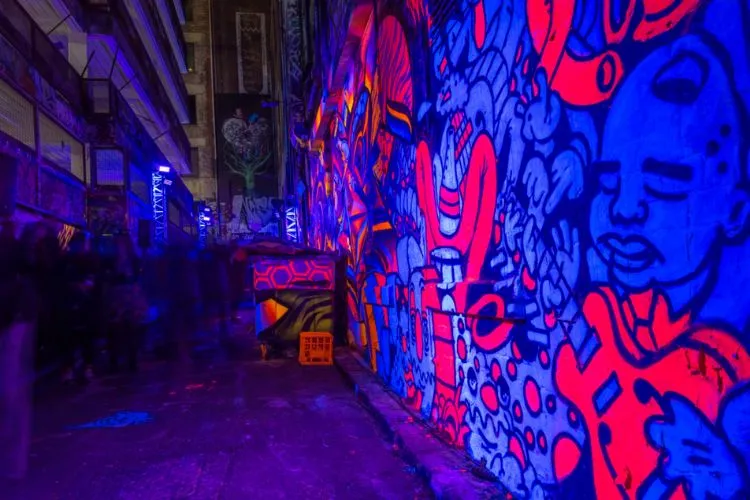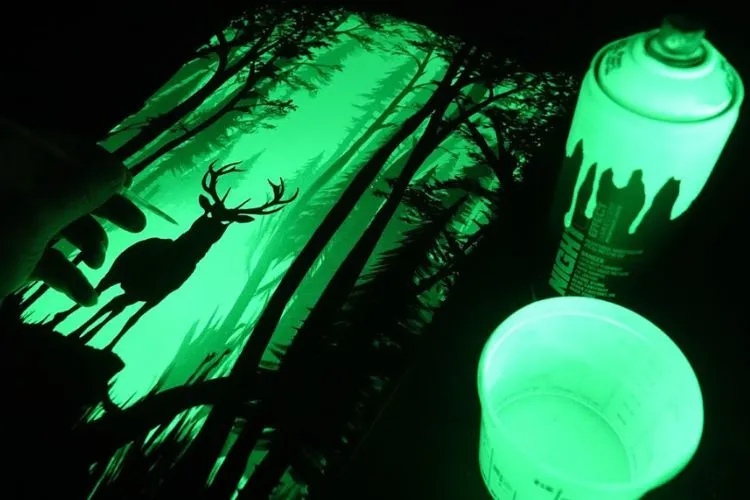Creating glow-in-the-dark paint merges the intriguing worlds of science and art, offering a unique twist to various projects.
Whether you’re into DIY crafts, customizing decor, or adding a safety feature to items, the application of glow-in-the-dark paint can transform ordinary objects into captivating pieces that grab attention in low-light conditions. Let’s learn how to make glow In the dark paint.

Understanding Glow in the Dark Paint
Phosphorescence is the scientific principle behind glow-in-the-dark materials. This process allows substances to emit light after being exposed to light, functioning similarly to a solar panel storing sunlight.
The main appeal of glow-in-the-dark paint lies in its ability to re-emit light, making it not only visually appealing but also practical in darkness.
While the concept of glow in the dark might sound complex, the making of such paint is surprisingly straightforward and safe, provided proper precautions are taken.
Materials Needed
The key ingredient is phosphorescent powder, which comes in various glow colors and lengths of luminescence. The quality of the powder directly impacts the intensity and duration of the glow, making it essential to select a high-quality product.

Alongside the powder, a suitable medium—commonly an acrylic base—is necessary to create the paint. For the preparation, you’ll need basic equipment such as mixing containers, stirring tools, and safety gear like gloves and glasses to protect against accidental inhalation or contact with the skin.
How To Make Glow In The Dark Paint?
Choosing the Right Phosphorescent Powder
Selecting the appropriate phosphorescent powder is the foundation of making effective glow-in-the-dark paint.
Consider particle size, glow color, and longevity to suit your project needs. Powders with finer particles mix more uniformly with the paint medium, delivering a smoother application and a more consistent glow.
Preparing the Workspace
Safety first. Ensure your workspace is well-ventilated and free from clutter. Don protective gear to minimize contact with the phosphorescent powder, which, while generally safe, should be handled carefully to avoid irritation or allergic reactions.
Mixing the Paint
Mixing is a critical step that determines the quality of the resulting paint. Start with a basic ratio of one part phosphorescent powder to five parts paint medium, adjusting according to the desired intensity of the glow.
Mix thoroughly to avoid lumps that could result in an uneven glow. Testing the paint in a dark room allows you to fine-tune the mixture before application.
Application Tips for Glow in the Dark Paint
For optimal results, surface preparation is key. A white base coat can significantly enhance the paint’s luminosity.
Choose the application method that best suits your project, and don’t shy away from applying multiple layers to achieve the desired effect, allowing each to dry thoroughly between applications.

Safety and Clean-Up
Ensuring safety while working with any form of paint, especially one containing chemical substances like phosphorescent powder, is crucial.
Adhere to proper disposal methods for any waste and clean your tools promptly to prevent the paint from hardening, making cleanup difficult.
Creative Uses for Glow in the Dark Paint
The versatility of glow-in-the-dark paint makes it suitable for an array of creative projects. From enhancing the aesthetic appeal of room decor to increasing the functionality of safety markers, the applications are virtually limitless.
Engaging in such projects not only feeds your creativity but can also offer practical benefits, like enhancing visibility in low-light conditions.
You may also find useful: How to Make Acrylic Paint More Opaque? | How to Prime Wood for Acrylic Painting?
DIY Project Ideas

Customizing T-Shirts and Fabrics
Making custom t-shirts glows in the dark is not only fun but can add a unique flair to clothing. Using stencils or freehand designs, you can create personalized apparel that stands out at night.
Transforming Spaces with Cosmic Themes
For those fascinated by the cosmos, applying a galaxy theme to ceilings or walls with glow-in-the-dark paint can create a mesmerizing effect. It’s an engaging way to bring the beauty of the night sky indoors.
Seasonal Decor with a Twist
Halloween and Christmas decorations gain an added dimension of intrigue when made with glow-in-the-dark paint. Whether it’s glowing pumpkins or shimmering Christmas ornaments, these decorations can elevate the festive atmosphere of your home.
Frequently Asked Questions (FAQs)
How Long Does Glow in the Dark Paint Last?
The persistence of the glow depends on various factors, including the quality of the phosphorescent powder and the amount of light exposure it receives. Generally, high-quality paints can maintain their luminescence for several hours after being charged.
Is Glow in the Dark Paint Safe for Skin?
While glow-in-the-dark paint is typically safe for most uses, it’s recommended to use products specifically labeled as safe for skin contact when applying to the body to avoid potential irritations.
Can Glow in the Dark Paint be Used Outdoors?
Yes, glow-in-the-dark paint can be applied outdoors, provided it’s sealed with a suitable clear coat to protect it from the elements, preserving its glow and extending its lifespan.
How Can I Make the Glow in the Dark Paint Glow Brighter?
A few methods can enhance the brightness of the glow, such as applying a white base coat, ensuring sufficient charging under bright light, and layering multiple coats of paint for increased intensity.
How Do I Charge Glow in the Dark Paint?
The best way to charge the paint is by exposing it to a strong light source, such as sunlight or bright indoor lighting, for a few hours. This “charging” process enables the paint to emit a stronger glow in dark conditions.
Is There an Alternative to Using Powder?
While phosphorescent powder is essential for creating traditional glow-in-the-dark paint, for temporary projects, alternatives like breaking open glow sticks and mixing the contents with a clear medium can offer a quick and temporary solution, though with less brightness and duration compared to traditional methods.
Conclusion:
Embracing the process of making and applying glow-in-the-dark paint opens up a world of creative possibilities. From practical applications like safety signs to artistic endeavors like cosmic-themed room decor, the potential uses are extensive.
With the guidance provided in this article, you’re well-equipped to explore the luminous possibilities that glow-in-the-dark projects offer.

Meet Isabella Anderson, your acrylic painting mentor with over a decade of brush-wielding mastery. Dive into the colorful world of acrylics with her expert guidance, featured exclusively on ‘Acrylic Authority.’ Unleash your inner artist and explore the limitless possibilities of this versatile medium alongside a true acrylic aficionado.
